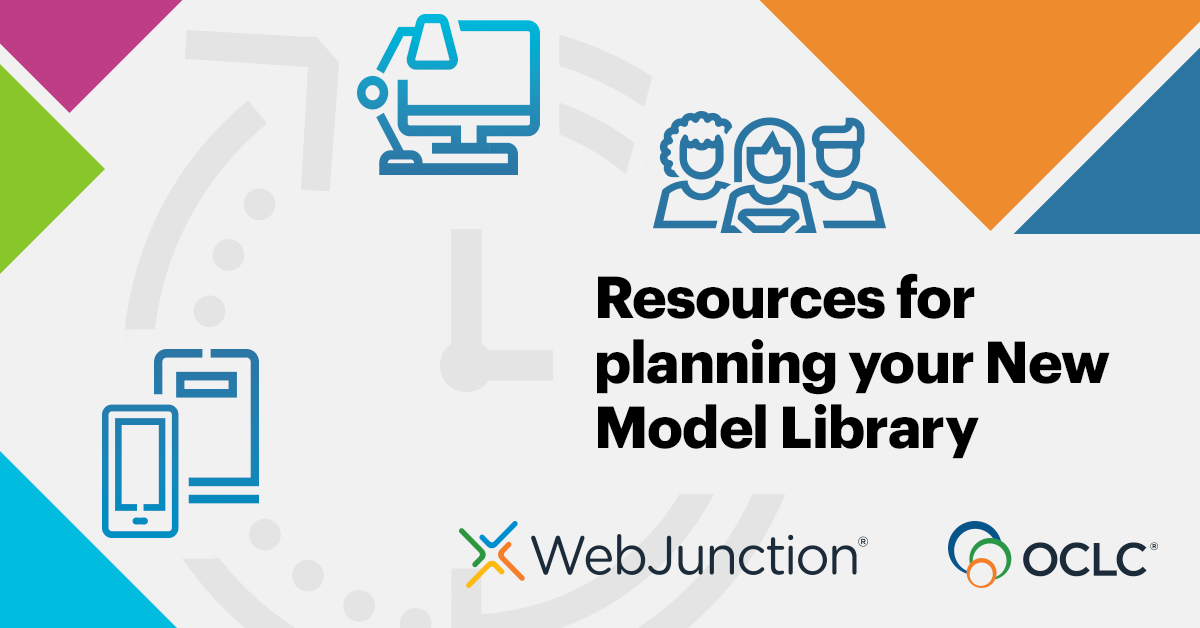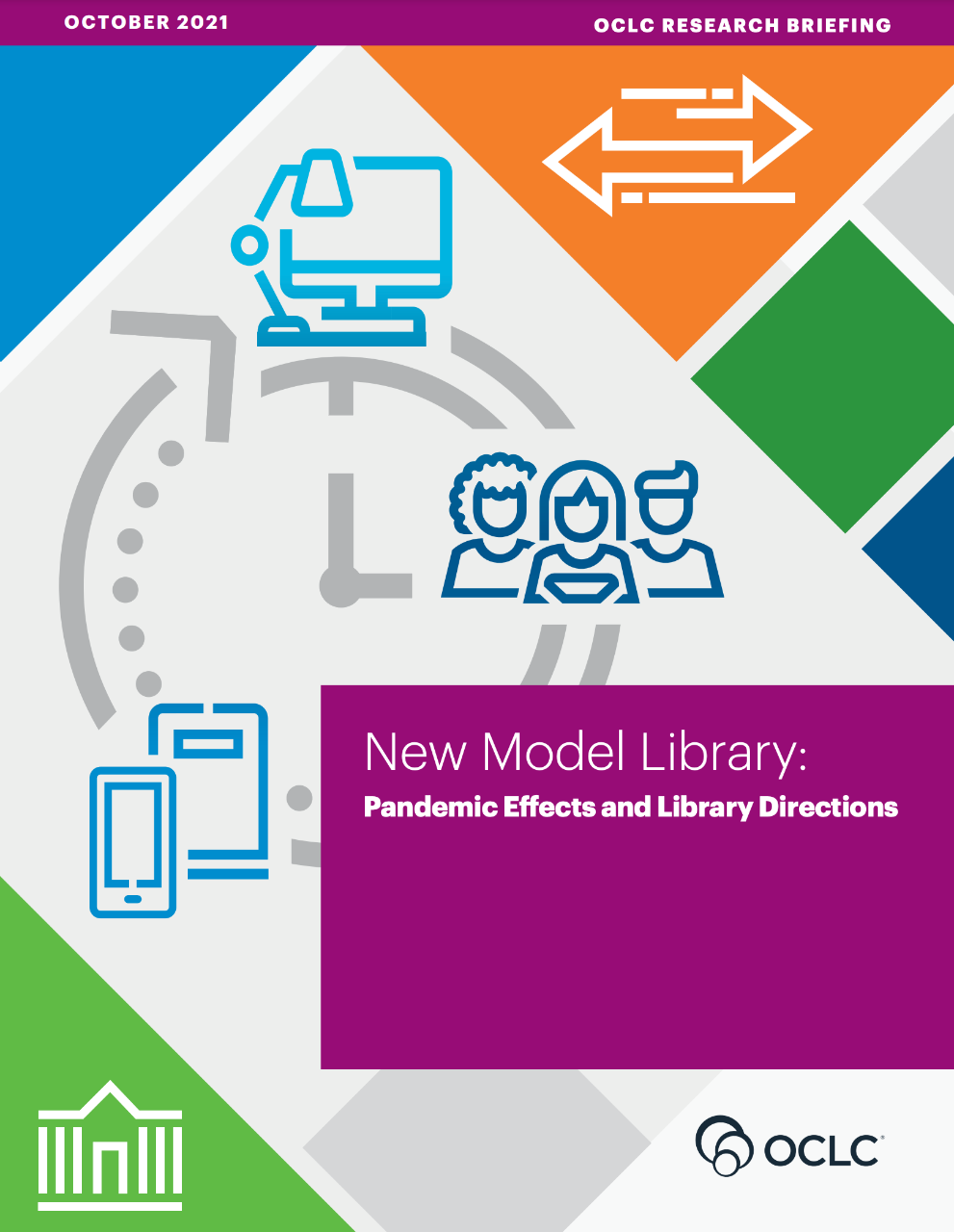Resources for Planning Your New Model Library

This article provides an overview of the New Model Library research, supporting learner guide, examples from public libraries, and information about an webinar on the topic. We hope that these materials can help facilitate local conversations between library leaders, staff, and stakeholders to support strategic decision making and planning for their organization. Some of the content here first appeared in the OCLC Next blog post, “New Model Library: Plan for positive change in the midst of challenges.”
Where do we go from here? Library leaders and staff are always adapting to meet evolving community needs, but the COVID-19 pandemic sent the pace of change into overdrive. While the COVID-19 pandemic remains a constant turbulent presence in libraries, the initial shock has transitioned into a new stage. Now, two years into the pandemic, library leaders and staff are reflecting on the innovations and lessons learned during the pandemic to plan for their “New Model Library.”
During the height of library closures in 2020, OCLC spoke with library leaders to learn about what they experienced during the early days of the pandemic and to capture leaders’ emerging vision for the future of their libraries. We describe these transformations—how leaders and staff strategically adapted to meet evolving needs and expectations—as movements toward a New Model Library. OCLC published the findings and recommendations synthesized from these conversations in the research briefing New Model Library: Pandemic Effects and Library Directions.
We hope the findings and recommendations in this publication can serve as a resource to support conversations locally that can help with strategic planning for your New Model Library. The briefing aims to help libraries find common ground with peers, identify new ideas and possible directions for their own organizations, and develop a shared context for future discussions. The accompanying learner guide is a tool that can support conversations with stakeholders in your library and community about what your organization experienced during the pandemic and discuss your collective ideas for the future.
Download the learner guide (available in PDF and Word)
By meeting with others to take time and reflect on what library leaders reported and how your institution compares, you can identify strengths to lean into and avoid taking actions that don’t fit your local context. In the process, you will develop the paths toward your New Model Library.
How to use the learner guide
We recommend having everyone that participates in learner guide discussions read the briefing first. Then, complete the first part of the learner guide, which is about reflecting on changes made during the pandemic, new community needs and expectations, what’s going well and should continue, and what changes need to be made. Next, gather everyone for a larger discussion about experiences, priorities, and visions for a New Model Library.
How much time you spend together will depend on what you want to accomplish. Our hope is that the conversation helps identify long-term priorities and ways to get started. The learner guide provides a broad outline for these activities, but you can tailor it to your organization and local context.
Insights and examples from public libraries
Here, we’ll offer insights from public library leaders on how the pandemic affected their institution’s staff and services across four areas of impact: agility, collaboration, virtualization, and space. This section also includes examples—drawn from the New Model Library research—of how you could apply the learner guide for your localized planning needs.
Work experiences
Public library staff’s work experiences often have been characterized by flexible and changing environments throughout the pandemic. To ensure that their staff is prepared for the shifting library landscape, library leaders we interviewed emphasized the need to prioritize training for the future. To realize this goal, leaders must commit to supporting continuous learning and professional development while ensuring that all staff, whether on-site or remote, have access to training time and resources needed, including IT support.
As the leader of an urban public library in Canada told us, “We are giving our librarians that training and continuing education for longer-term librarians . . . to keep our staff trained and upskilled because we are operating in a massively changing environment.” This finding would make a great point of discussion among staff to help identify learning goals, needs, and priorities that make sense for your institution. How can the library make sure it can deliver cutting-edge service in an ever-changing environment?
Another major finding was the need to focus on staff well-being. The pandemic’s emotional toll on staff should not be underestimated. Some library leaders emphasized the need for empathy in helping staff successfully cope with the stress of the pandemic: “Yeah, the staff has thanked me several times for being aware of their feelings and emotions and not just moving forward like a steamroller, but still moving forward” (Urban Public, US).
Ensuring that staff have the time and resources to tend to their well-being will be essential as we move forward.
These two highlights from the work experiences section are examples of areas you might choose to prioritize, agreeing on what the desired outcomes would be and how to develop a plan to support these outcomes.
Collections experiences
The digital divide loomed large over the pandemic, and library leaders and staff are very concerned about how to serve community members unable to access online services. An urban public library leader in Canada explained that reaching people who fell into the digital divide was a great concern for their library: “That’s a large part of our patrons, people who are without a home or people who are alone. We sense that’s the role of the libraries in the community and break the isolation.”
Leaders are prioritizing resources to close the digital divide, and that looks different in each community. A New Model Library will meet community needs for connectivity and software as well as devices that enable virtual engagement with the library’s collections and offerings. Is this a priority for your library? How can the library make sure no one in the community is left behind?
Additionally, physical materials continue to be an important and valued part of library offerings, but how users connect with these materials is changing. A leader of a suburban public library in the US began a virtual readers’ advisory program during the pandemic that they previously had been unable to create due to other programming commitments. For readers who do not have digital access to place their own holds or who are not able to browse the stacks, staff place holds for readers based on their favorite genres. Staff report that this approach helps them connect with readers in new ways. A New Model Library also could include transitioning contactless delivery from a pandemic necessity into a valued convenience.
Engagement experiences
Both virtual and in-person engagements are here to stay, but library leaders are grappling with what that means for their community. One leader from an urban public library in the US imagined their library becoming a central place where the community would share its pandemic needs and heal resulting wounds:
“Well, I would hope [our library] would reemerge from this time of isolation as a vital community hub . . . that libraries are the places we come to talk about what we learned . . . not as a library, but as a community . . . So what's going to emerge once we come out of this that are real wounds in our communities and I think libraries can be a place where those discussions can happen, where we can help communities make decisions.”
While leaders are eager to invite engagement in the physical space, they know that the accessibility of hybrid options can increase reach and add value. It is a tricky balance to strike, and the learner guide offers a way to begin those discussions with your community.
Public library leaders and staff also invested in community partnerships to help address new or intensified needs throughout the pandemic. An urban public library leader in Canada shared their experiences partnering with local food banks:
“We established these really great partnerships with these food banks and they understood the library and we understood food banks way more . . . and now we have two food banks that continue to be distributed to two of our branches . . . We saw so many of our regular library customers . . . and they said . . . ‘I don’t have to walk into a place that says it’s a food bank. I’m walking into a library to get my food’. . . [We also] started putting children’s books in the [food bank] hampers.”
This partnership added value for both organizations and most importantly, served community needs better.
Sounds great, but what next?
Ultimately, the New Model Library research briefing and learner guide are resources that we hope can help start a conversation among library leaders, staff, and stakeholders about what strategies, models, and priorities are going to have the most impact on their institutions and communities. Here are some steps you can take to learn more about this framework and how you might utilize these resources at your institution:
- Download and read the research briefing, New Model Library: Pandemic Effects and Library Directions.
- Download the accompanying learner guide (available in PDF and Word) and organize a discussion with staff at your library.
- Recording for the February 2022 webinar “Libraries and Open Ecosystems: Creating a New Model Library.” This session features a panel discussion with library leaders on the future of libraries.
- Recording for the July 2022 webinar "Creating a New Model Library."
- Read more about this project from the OCLC Next blog: “The New Model Library. Welcome home” and “New Model Library: Plan for positive change in the midst of challenges.”
Short URL: oc.lc/new-model-library




